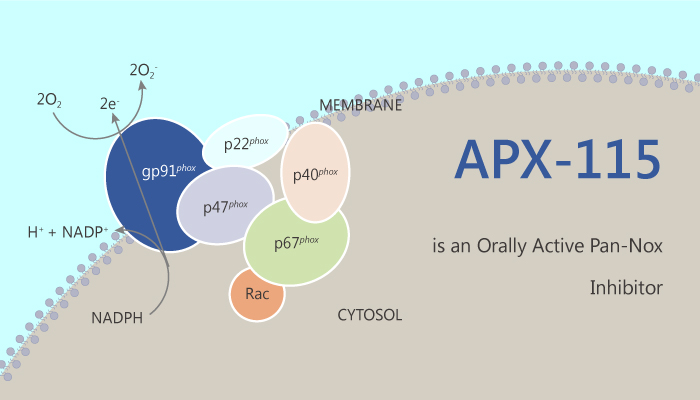NADPH oxidase (nicotinamide adenine dinucleotide phosphate oxidase; Nox) is a membrane-bound enzyme complex, which faces extracellular space. It catalyzes the production of superoxide free radical through transferring an electron from NADPH to oxygen. The enzyme contains NOX1-5, DUOX1, and DUOX2. It plays an important role in the balance of ROS production. Today, we are going to talk about APX-115, a pan NADPH oxidase Inhibitors in the following research.

Guideock Kwon, et al carried out a series of experiments to examine the bioactivity of APX-115. They chose six-week-old male C57BL/6 mice to establish the diabetic model. Mice are treated with streptozotocin (STZ) for 5 days to induce diabetes. Then, researchers divided the animals into four groups, including the control group, diabetic group, the diabetic group with APX-115 as well as diabetic group with losartan. APX-115 treatment is at a dose of 60 mg/kg/day via oral administration for 12 weeks.
As a result, APX-115 exhibits excellent in vivo activity. To begin with, APX-115 prevents albuminuria and suppresses hyperfiltration and glomeruler hypertrophy in diabetic mice. It also blocks tubular, inhibits podocyte injury and kidney fibrosis in diabetic mice. The compound reduces the increase in urinary and kidney KIM1 as well as NGAL mRNA expression induced by STZ. It significantly reverses the inhibition of nephrin expression.
Besides, APX-115 prevents kidney inflammation and oxidative stress in diabetic mice. It decreases the increased levels of TNFα and MCP1 mRNA expression induced by STZ. The inhibitor also blocks diabetes-induced plasma, urine, and kidney lipid hydroperoxide.
Last but not least, APX-115 prevents lipid accumulation and has the potential in regulating mitochondrial and peroxisomal biogenesis diabetic mice.
References:
1. Kwon G, et al. Oncotarget. 2017 Jun 16;8(43):74217-74232.